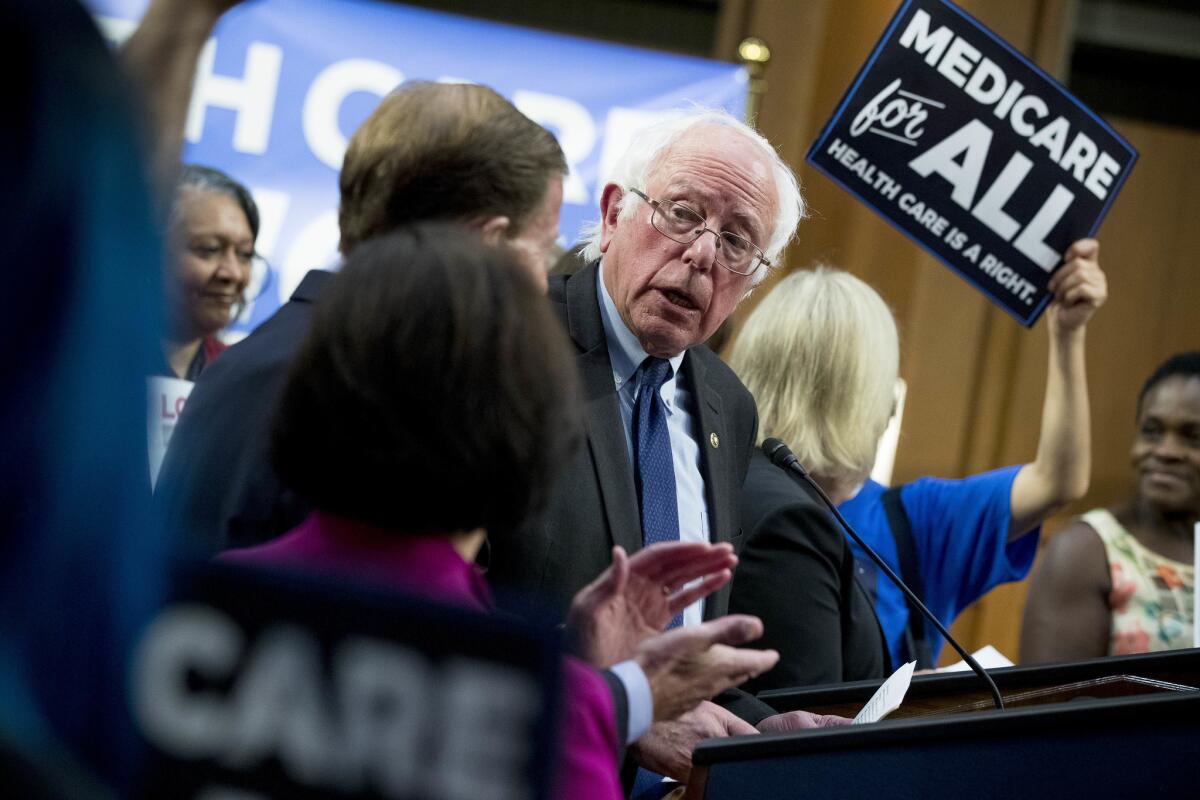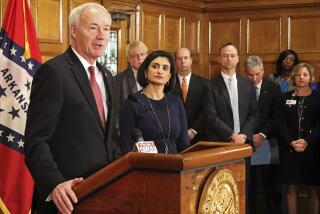Opinion: Even with ‘Medicare for all,’ we’ll still need Medicaid

- Share via
As the nation moves into the next round of Democratic presidential debates, Sen. Bernie Sanders’ “Medicare for All” bill and others like it are once again expected to receive intensive focus. Unfortunately, the consequences for Medicaid, the nation’s single largest public insurer, have gone virtually undiscussed.
This is a mistake. Any move toward a single-payer system needs to take account of Medicaid’s future and the more than 70 million Americans it covers — disproportionately people of color — who live in the most vulnerable urban and rural communities, marked by poverty, elevated health risks and a chronic shortage of accessible services.
It is tempting to dismiss Medicaid, Medicare’s stepchild when it first became law in 1965. Indeed, its opponents have long criticized the program for being inefficient and beset by cost, operational and performance problems.
Time and again, these characterizations have been proved wrong. Countless studies since Medicaid’s inception have shown its positive effect on improving healthcare access and outcomes and in narrowing the health equity gap between rich and poor Americans. Government studies have also shown that, measured on a head-to-head basis, Medicaid costs substantially less than private coverage.
Medicaid’s flexibility as a joint state-federal partnership is enormously important, making it able to adapt to local conditions and to respond rapidly to the most serious crises. Although Medicaid coverage for the poor differs greatly from state to state, it is in all states a public health first responder. It is the means by which states provide extra resources to trauma centers responding to casualties from mass shootings. It is used to help communities deal with the Zika virus, fund access to drug therapies for HIV/AIDS and combat the opioid epidemic.
Medicaid investments underpin the healthcare infrastructure in at-risk communities, keeping their clinics and hospitals stable and able to function. In these respects, every insurer, including Medicare, relies on Medicaid as the foundation for its operations.
Medicaid’s enrollment process is also exceptional in the American coverage system. Even when public and private health insurance plans don’t bar coverage for people with preexisting conditions, they typically do not allow people to enroll when they actually need healthcare services. Prospective enrollment stabilizes insurance risk pools. But it also bars access to insurance at the time people use care, leaving those who fall through the cracks totally uncovered.
By contrast, eligible patients can enroll in Medicaid when they need care. And by allowing coverage to take effect retroactively, up to three months prior to the date of enrollment, Medicaid shields eligible individuals and healthcare providers from catastrophic costs that would otherwise go uncovered.
These public health imperatives will still exist regardless of which broad reforms take hold — Medicare for all included. Insurance pays for care in smoothly operating healthcare systems. It is not a tool for quickly scaling up treatment capacity, attacking rapidly unfolding public health crises or getting entire healthcare systems back on their feet following a catastrophe. Every nation, whatever its healthcare structure, needs this nimbleness. Partly by design and partly by circumstance, Medicaid has served that function well.
Congress could certainly fashion a Medicare-for-all or single-payer model that does double duty as a uniform nationwide insurer and a highly flexible public health safety net. All Americans should have coverage for basic healthcare services. But universal insurance by itself won’t possess Medicaid’s flexibility, which allows the federal government and state governments to respond rapidly when more than a standard insurance approach is called for.
It might be possible to broaden the Medicare-for-all model to include Medicaid’s essential public health functions like immediate access to coverage, comprehensive benefits that go beyond what insurance plans typically cover, and rapid deployment of emergency resources in times of need. But adding this enormous set of public health functions to a Medicare-for-all approach would either make the legislation collapse under its own weight or imperil Medicaid, reducing it yet again to a legislative afterthought and endangering the patients and communities that depend on this flexibility.
This country may decide to adopt some form of a single-payer system, but we cannot forget that insurance is only one part of a much larger public health discussion. The future of Medicaid — regardless of how people are insured — is as serious a health policy issue as they come.
Sara Rosenbaum is a professor of health law and policy at the Milken Institute School of Public Health at George Washington University. Stephen Warnke, a healthcare lawyer with Ropes & Gray, counsels providers and plans on regulatory and enforcement matters.
More to Read
A cure for the common opinion
Get thought-provoking perspectives with our weekly newsletter.
You may occasionally receive promotional content from the Los Angeles Times.









